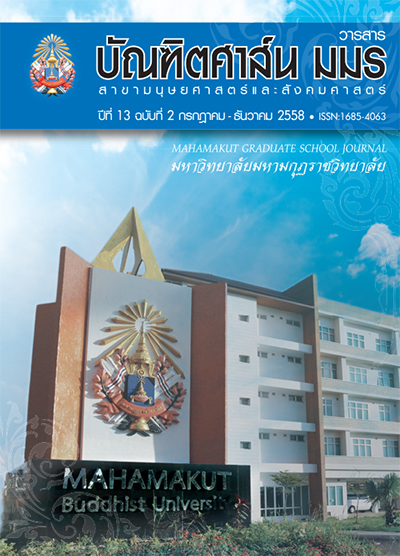ศึกษาขณิกสมาธิในการปฏิบัติวิปัสสนาภาวนา ตามแนวมหาสติปัฏฐานสูตร
คำสำคัญ:
ขณิกสมาธิ, วิปัสสนาภาวนา, มหาสติปัฏฐานสูตรบทคัดย่อ
การศึกษานี้ มีวัตถุประสงค์ 3 ประการ คือ (1) เพื่อศึกษาขณิกสมาธิในคัมภีร์พุทธศาสนาเถรวาท (2) เพื่อศึกษาวิปัสสนาภาวนาในมหาสติปัฏฐานสูตร และ (3) เพื่อศึกษาขณิกสมาธิในการปฏิบัติวิปัสสนา ภาวนาตามแนวมหาสติปัฏฐานสูตร การศึกษานี้เป็น งานวิจัยเชิงคุณภาพ และจากการศึกษาได้พบว่า
ขณิกสมาธิ คือ สมาธิชั่วขณะ เกิดขึ้นได้ในขณะ คนเรามีจิตจดจ่ออยู่กับสิ่งใดสิ่งหนึ่งเป็นเวลานานๆ แต่สมาธินี้เมื่อนำมาใช้ในการเจริญวิปัสสนาภาวนา ด้วยการกำหนดสภาวะปรมัตถ์ของรูปนาม เป็นไป ตามความเปน็ จริง ก็เป็น ธรรมนำไปสู่การสิ้นทุกขโ์ดย สิ้นเชิงได้ ท่านเรียกขณิกสมาธิในการเจริญวิปัสสนา นี้ว่า วิปัสสนาขณิกสมาธิ สมาธินี้เกิดขึ้นเป็นไปทุกๆ ขณะอย่างต่อเนื่องกันไป ที่กำหนดรูปนามของโยคี ผู้ปฏิบัติ
การปฏิบัติวิปัสสนาภาวนาตามแนวมหาสติ ปัฏฐานสูตรของวิปัสสนายานิกบุคคล จำต้องพัฒนา ขณิกสมาธิที่เกิดจากการที่โยคีผู้ปฏิบัติ อบรมสติใน ฐาน 4 คือ กาย เวทนา จิต และธรรม ซึ่งจะพัฒนา ตัวไปพร้อมกับธรรมอื่นๆ ในโพธิปักขิยธรรม 37 ประการ เมื่อวิปัสสนาปัญญาแก่กล้ามากขึ้น เมื่อ ถึงอุทยัพพยญาณ ขณิกสมาธิที่ร่วมกับปัญญา ก็จะ ทำการละกิเลสตามหน้าที่ของตนได้มากขึ้น จนกิเลส มีโอกาสเข้าสู่จิตได้น้อย ความทุกข์ก็จะเบาบางลง จนในที่สุดเมื่อวิปัสสนาปัญญาแก่กล้าเต็มที่ จิตก็จะ มีความมั่นคง มีกำลัง เข้าไปสนับสนุนให้ปัญญาเห็น แจ้งรูปนามได้อย่างละเอียดหมดจด จนเห็นอริยสัจ และประหานกิเลสได้อย่างเด็ดขาด เป็นสมุจเฉทปหาน ด้วยอำนาจมรรคญาณในที่สุด
เอกสารอ้างอิง
ก. ข้อมูลปฐมภูมิ (Primary Sources)
มหาจุฬาลงกรณราชวิทยาลัย. พระไตรปิฎกภาษาบาลี ฉบับมหาจุฬาเตปิฏกํ 2500. กรุงเทพมหานคร: โรงพิมพ์มหา จุฬาลงกรณราชวิทยาลัย, 2535.
พระไตรปิฎกภาษาไทย ฉบับมหาจุฬาลงกรณราชวิทยาลัย. กรุงเทพมหานคร: โรงพิมพ์มหาจุฬาลงกรณราช วิทยาลัย, 2539.
อรรถกถาภาษาบาลี ฉบับมหาจุฬาอฏฐกถา. กรุงเทพมหานคร: โรงพิมพ์ วิญญาณ. โรงพิมพ์มหาจุฬาลงกรณราช วิทยาลัย, 2532-2534.
ฎีกาภาษาบาลี ฉบับมหาจุฬาฎีกา. กรุงเทพมหานคร: โรงพิมพ์มหาจุฬาลงกรณราช วิทยาลัย, 2539.
พระพุทธโฆสาจารย์. วิสุทฺธิมคฺคสฺส นาม ปกรณวิเสสสฺส ปฐโม ภาโค – ตติโย ภาโค. ตรวจชําระ โดยสมเด็จพระวันรัต (เฮง เขมจารีเถระ). พิมพครั้งที่ 10.กรุงเทพมหานคร: มหามกุฏ ราชวิทยาลัย, 2548.
สมเด็จพระพุฒาจารย์ (อาจ อาสภมหาเถระ). คัมภีร์วิสุทธิมรรค แปล. พิมพ์ครั้งที่ 4. กรุงเทพมหานคร: ประยูรวงศ์ พริ้นติ้ง จํากัด, 2546.
ธัมมปาลมหาเถระ. ปรมตฺถมญฺชุสา นาม วิสุทฺธิมคฺคสํวณฺณนา มหาฏีกา. พิมพ์ครั้งที่ 8. กรุงเทพมหานคร: มหามกุฏราชวิทยาลัย, 2536.
ข. ข้อมูลทุติยภูมิ (Secondary Sources)
(1) หนังสือ:
พระธรรมธีรราชมหามุนี (โชดก ป.ธ.9). วิปัสสนาญาณโสภณ. พิมพ์ครั้งที่ 3. กรุงเทพมหานคร: บริษัทศรีอนันต์การ พิมพ์ จํากัด, 2546.
พระโสภณมหาเถระ (มหาสีสยาดอ). มหาสติปัฏฐานสูตร ทางสู่พระนิพพาน. พระพรหมโมลี (สมศักดิ์ อุปสมมหา เถระ ป.ธ.9, M.A.,Ph.D.) ผู้ตรวจชําระ. พระคันธสาราภิวงศ์ แปล และเรียบเรียง. กรุงเทพมหานคร: จัดพิมพ์โดย ห้างหุ้น ส่วนจํากัด ไทยรายวันการพิมพ์, 2549.
วรรณสิทธิ ไวทยเสวี. คู่มือการศึกษา พระอภิธัมมัตถสังคหะ ปริจเฉทที่ 2 เจตสิกสังคหวิภาค. กรุงเทพมหานคร: ทิพยวิสุทธิ์ การพิมพ์, พ.ศ. (ไม่ปรากฏ).
ดาวน์โหลด
เผยแพร่แล้ว
รูปแบบการอ้างอิง
ฉบับ
ประเภทบทความ
สัญญาอนุญาต
บทความวิชาการและบทความวิจัยในวารสารฉบับนี้ถือเป็นความรับผิดชอบของผู้เขียนเท่านั้น บทความที่ได้รับการตีพิมพ์ในวารสารบัณฑิตศาส์น ถือเป็นลิขสิทธิ์ของมหาวิทยาลัยมหามกุฏราชวิทยาลัย ตามพระราชบัญญัติลิขสิทธิ์



